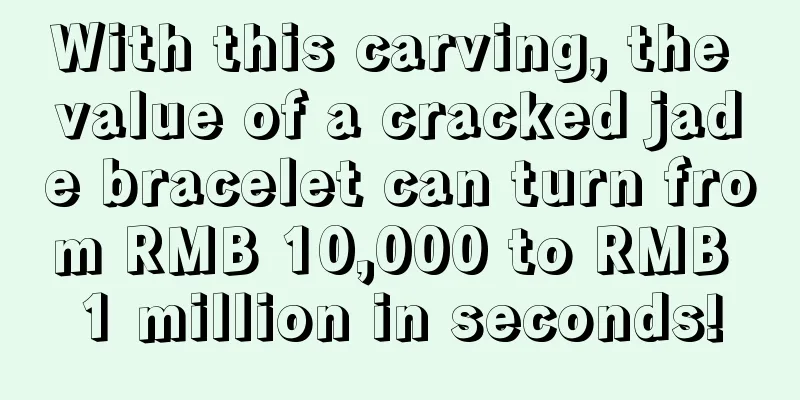In practice, there are 7 methods to judge the authenticity of jadeite, but they are all wrong!

|
The identification methods of jadeite can be roughly divided into two categories: one is to use scientific instruments for testing, and the other is to summarize daily experience. The theoretical basis for summarizing daily experience is closely related to jade knowledge. Its characteristics are that it can be operated by individuals and is simple and easy to implement. Theory comes from practice and can guide practice, but not all theories have practical significance. The following daily identification theory derived from jade knowledge deviates from practice and other theories. It is operational but cannot be operated or put into practice and can only remain at the theoretical basis level. 1. Water dripping observation Method: Drop a drop of water onto the surface of the finished jade product. If it condenses into water droplets, it proves to be A-grade jade. If it disperses, it is B or C-grade jade. Practice proves: ridiculous theory. If the finished jade product is sealed with wax, even if water is dripped on it, the water drops will not spread out. Whether the water droplets spread out should be related to the smoothness of the jade surface, and has no direct relationship with A-grade, B-grade, or C-grade jade. 2. Scratching glass with jadeite Method: Jade is harder than glass and can scratch glass. Practice has proved that the hardness of jade is 7, while the hardness of ordinary glass is only 5. In theory, the hardness of jade is greater than that of glass. Can scratch glass. B-grade and C-grade jadeite, agate, nephrite, serpentine, quartzite jade, etc. are all harder than glass. In theory, they can all scratch glass. In a broad sense, any material harder than glass can scratch glass. However, jadeite A-grade can not necessarily leave scratches on glass. This statement replaces the concept. It only compares the hardness of the materials, not whether they are genuine products. 3. Sour roasting method Method: Rub concentrated acid on the back of the jadeite, then bake it with a red-hot pin, repeat this process. If you see yellow and burnt spots on the back of the jadeite, it means the jadeite is not a genuine product. Practice has shown that rubbing concentrated acid on the back of jade will cause corrosion damage to the jade, so it should never be practiced. 4. Tap and listen to the sound Method: Knock the jades against each other. If a crisp, pleasant, steel-like sound is produced, it is natural jade. Practice has proved that after acid washing and filling with glue, the sound of B-grade jadeite will change and become slightly duller. If less glue is filled, the sound will not change much. The dyed C-grade jadeite also makes a steel sound when knocked. In addition, water foam jade, diopside, etc. also make a steel sound when knocked. Whether it is a pendant or a carving, large or small, the value of the finished jade product varies. If you knock it, it will inevitably cause hard damage such as broken edges and breakage, which is really taboo for merchants. Even if it is a finished jade product that you own, you probably won't be willing to knock it. 5. Observe the fly wings of jadeite Method: The fly wings of jadeite are an important feature that distinguishes natural jadeite from other jades, and are an important sign for determining whether jadeite is natural. Practice has proved that the fly wings of jadeite refer to the fact that when the surface of jadeite is illuminated by light, its jadeite mineral cleavage surface appears with long strips or irregular flakes of bright white flashes, just like the wings of a fly. After cutting the raw jadeite stone, the cutting saw blade will cause the cleavage cracks of the jadeite minerals near the jadeite cut to produce cleavage planes, so the presence of fly wings can be observed on the rough cut surface. However, for finished jade products, the surface after polishing is regular and smooth, with no cleavage planes, and it is impossible to observe the characteristics of fly wings. 6. Soak with boiling water Method: When C-grade jadeite is soaked in boiling water, the color will dissolve in the water. Practice has proved that the colorant of dyed jade enters the jade along the cracks, precipitates and accumulates in the cracks and crystal gaps between the particles. When exposed to light, heat or oxidation by air, the original bright color will fade. However, after the sealing wax treatment, the colorant can be kept in a safe state. Soaking in boiling water will cause certain damage to the wax, but it will not necessarily cause the color to fade. 7. Scrape the surface of the jade with a sharp knife Method: During the production process of B-grade jadeite, the jadeite is soaked in strong acid, which destroys its internal structure. The structure becomes loose and cracked, so epoxy resin glue must be injected into the interior of the jadeite for filling and reinforcement. At the same time, there is a large amount of epoxy resin glue on the surface of the jadeite, so a sharp knife can scrape off the debris. Practice has proved that epoxy resin glue is hard and corrosion-resistant, and it is basically impossible to scrape it off with a knife. If you want to scrape off the particles, the finished jade product would be basically completely wrapped in epoxy resin glue, and the wrapping would be extremely thick, which is somewhat unimaginable. The above 7 practical identification methods are used by many people in the industry. It does not mean that these methods are unreliable. The key is that we must grasp the scale. For example, methods such as knocking and scraping will damage the jade itself. You must know that a good jade cannot tolerate even a little damage. The most scientific method is to use scientific instruments for testing. After all, experience can be wrong, and everyone can be deceived. The machine detects what it is, and no one can deceive it. fcgc66 fcpf18 |
>>: What does A-grade jadeite mean? How to tell whether jade is A grade?
Recommend
What does the 'spicy color' of jadeite mean? What is the unified standard?
The Chinese people's love for jade is unmatch...
Enjoy the beauty of jade - the exquisitely carved baby Buddha series
The sketches of four Buddhas, combined with exqui...
The jade carving technique of Jieyang
Jade requires "three parts water and seven p...
Choose the most beautiful and valuable Meicui, you must know these methods
Golden-thread jadeite refers to jadeite in which ...
When choosing jadeite, is raw jade cheaper? Or is the finished product cheaper?
Buying rough jade is 30% to 50% cheaper than buyi...
Make good use of jadeite raw stones, there is very little waste, let's talk about jadeite carving
As the old saying goes, "If jade is not carv...
The charm of jade bracelets sets off your extraordinary temperament
Jade bracelets are accessories with traditional C...
How to Identify Acid-Washed Jade
Natural jade is graded into different quality lev...
Ice-glutinous jade and glutinous ice jade are actually different
Today I plan to continue shopping around jade and...
Jade cultural heritage, spiritual heritage and investment value
Jade was introduced to China from Myanmar in the ...
When the finest jadeite meets exquisite carving, every piece of work is irresistible.
Sharing jadeite raw stones with you every day wil...
Let’s take a look at the methods commonly used to identify the authenticity of jadeite. Which one have you used?
How to identify the authenticity of jadeite is so...
The simplest way to identify jadeite, share 3 steps to identify it
Regarding jadeite, as consumers, in addition to b...
The original jadeite from Damakan is exquisite and lovely after being carved
"One cut can make you poor, another cut can ...
Do you know the meanings of the twenty common jade carving themes?
Chinese sculpture art can be said to be a particu...









